China's Shanxi makes great efforts to protect and study Yungang Grottoes
新華網(wǎng)
Editor: huaxia
2025-04-23 07:22:35

Wang Yanqing (L), a staff member of the research institute of the Yungang Grottoes, conducts an archaeological investigation at the grottoes in Datong, north China's Shanxi Province, April 15, 2025. Yungang Grottoes was built during the Northern Wei Dynasty (386-534). It is considered a pinnacle of Chinese Buddhist art and represents the highest level of sculptural artistry in the world during the 5th century.
In recent years, Shanxi has made great efforts to protect and study the grottoes. In 2021, the research institute of the Yungang Grottoes was established for the protection, research and management of the Yungang Grottoes.
Since 2003, the UNESCO World Heritage Site has started the digitization of its 45 major caves and more than 59,000 stone statues that are threatened by weathering. Cutting-edge technology has been used to record details of the Buddhist artworks, paving the way for their 3D digital reconstruction.
At present, the Yungang Grottoes scenic area has upgraded tourist facilities and offers various educational programs, receiving 4.44 million trips in 2024. (Xinhua/Yang Chenguang)

Sun Lina, a staff member of the research institute of the Yungang Grottoes, dusts a cultural relic of the grottoes at the institute in Datong, north China's Shanxi Province, April 15, 2025. Yungang Grottoes was built during the Northern Wei Dynasty (386-534). It is considered a pinnacle of Chinese Buddhist art and represents the highest level of sculptural artistry in the world during the 5th century.
In recent years, Shanxi has made great efforts to protect and study the grottoes. In 2021, the research institute of the Yungang Grottoes was established for the protection, research and management of the Yungang Grottoes.
Since 2003, the UNESCO World Heritage Site has started the digitization of its 45 major caves and more than 59,000 stone statues that are threatened by weathering. Cutting-edge technology has been used to record details of the Buddhist artworks, paving the way for their 3D digital reconstruction.
At present, the Yungang Grottoes scenic area has upgraded tourist facilities and offers various educational programs, receiving 4.44 million trips in 2024. (Xinhua/Zhan Yan)

A tourist selects cultural and creative products at a shop near Yungang Grottoes in Datong, north China's Shanxi Province, April 16, 2025. Yungang Grottoes was built during the Northern Wei Dynasty (386-534). It is considered a pinnacle of Chinese Buddhist art and represents the highest level of sculptural artistry in the world during the 5th century.
In recent years, Shanxi has made great efforts to protect and study the grottoes. In 2021, the research institute of the Yungang Grottoes was established for the protection, research and management of the Yungang Grottoes.
Since 2003, the UNESCO World Heritage Site has started the digitization of its 45 major caves and more than 59,000 stone statues that are threatened by weathering. Cutting-edge technology has been used to record details of the Buddhist artworks, paving the way for their 3D digital reconstruction.
At present, the Yungang Grottoes scenic area has upgraded tourist facilities and offers various educational programs, receiving 4.44 million trips in 2024. (Xinhua/Zhan Yan)
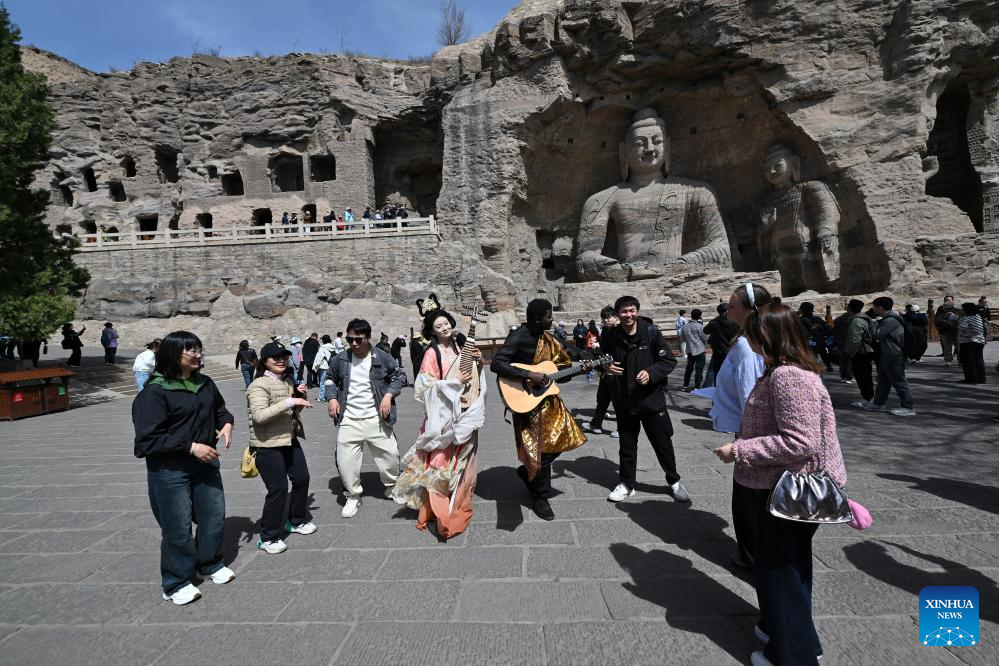
Actors dressed in costume interact with tourists at Yungang Grottoes in Datong, north China's Shanxi Province, April 15, 2025.
Yungang Grottoes was built during the Northern Wei Dynasty (386-534). It is considered a pinnacle of Chinese Buddhist art and represents the highest level of sculptural artistry in the world during the 5th century.
In recent years, Shanxi has made great efforts to protect and study the grottoes. In 2021, the research institute of the Yungang Grottoes was established for the protection, research and management of the Yungang Grottoes.
Since 2003, the UNESCO World Heritage Site has started the digitization of its 45 major caves and more than 59,000 stone statues that are threatened by weathering. Cutting-edge technology has been used to record details of the Buddhist artworks, paving the way for their 3D digital reconstruction.
At present, the Yungang Grottoes scenic area has upgraded tourist facilities and offers various educational programs, receiving 4.44 million trips in 2024. (Xinhua/Zhan Yan)

Tourists visit Yungang Grottoes in Datong, north China's Shanxi Province, April 15, 2025. Yungang Grottoes was built during the Northern Wei Dynasty (386-534). It is considered a pinnacle of Chinese Buddhist art and represents the highest level of sculptural artistry in the world during the 5th century.
In recent years, Shanxi has made great efforts to protect and study the grottoes. In 2021, the research institute of the Yungang Grottoes was established for the protection, research and management of the Yungang Grottoes.
Since 2003, the UNESCO World Heritage Site has started the digitization of its 45 major caves and more than 59,000 stone statues that are threatened by weathering. Cutting-edge technology has been used to record details of the Buddhist artworks, paving the way for their 3D digital reconstruction.
At present, the Yungang Grottoes scenic area has upgraded tourist facilities and offers various educational programs, receiving 4.44 million trips in 2024. (Xinhua/Zhan Yan)

Tourists visit Yungang Grottoes in Datong, north China's Shanxi Province, April 16, 2025. Yungang Grottoes was built during the Northern Wei Dynasty (386-534). It is considered a pinnacle of Chinese Buddhist art and represents the highest level of sculptural artistry in the world during the 5th century.
In recent years, Shanxi has made great efforts to protect and study the grottoes. In 2021, the research institute of the Yungang Grottoes was established for the protection, research and management of the Yungang Grottoes.
Since 2003, the UNESCO World Heritage Site has started the digitization of its 45 major caves and more than 59,000 stone statues that are threatened by weathering. Cutting-edge technology has been used to record details of the Buddhist artworks, paving the way for their 3D digital reconstruction.
At present, the Yungang Grottoes scenic area has upgraded tourist facilities and offers various educational programs, receiving 4.44 million trips in 2024. (Xinhua/Zhan Yan)

An Yongfang (L) and Wei Songlin, staff members of the research institute of the Yungang Grottoes, prepare for a study tour activity at the institute in Datong, north China's Shanxi Province, April 15, 2025. Yungang Grottoes was built during the Northern Wei Dynasty (386-534). It is considered a pinnacle of Chinese Buddhist art and represents the highest level of sculptural artistry in the world during the 5th century.
In recent years, Shanxi has made great efforts to protect and study the grottoes. In 2021, the research institute of the Yungang Grottoes was established for the protection, research and management of the Yungang Grottoes.
Since 2003, the UNESCO World Heritage Site has started the digitization of its 45 major caves and more than 59,000 stone statues that are threatened by weathering. Cutting-edge technology has been used to record details of the Buddhist artworks, paving the way for their 3D digital reconstruction.
At present, the Yungang Grottoes scenic area has upgraded tourist facilities and offers various educational programs, receiving 4.44 million trips in 2024. (Xinhua/Yang Chenguang)

Zhang Fan, a staff member of the research institute of the Yungang Grottoes, dissolves the sample of the grottoes wall at the institute in Datong, north China's Shanxi Province, April 16, 2025. Yungang Grottoes was built during the Northern Wei Dynasty (386-534). It is considered a pinnacle of Chinese Buddhist art and represents the highest level of sculptural artistry in the world during the 5th century.
In recent years, Shanxi has made great efforts to protect and study the grottoes. In 2021, the research institute of the Yungang Grottoes was established for the protection, research and management of the Yungang Grottoes.
Since 2003, the UNESCO World Heritage Site has started the digitization of its 45 major caves and more than 59,000 stone statues that are threatened by weathering. Cutting-edge technology has been used to record details of the Buddhist artworks, paving the way for their 3D digital reconstruction.
At present, the Yungang Grottoes scenic area has upgraded tourist facilities and offers various educational programs, receiving 4.44 million trips in 2024. (Xinhua/Yang Chenguang)

Li Pengfei, a staff member of the research institute of the Yungang Grottoes, restores porcelain of the grottoes at the institute in Datong, north China's Shanxi Province, April 15, 2025. Yungang Grottoes was built during the Northern Wei Dynasty (386-534). It is considered a pinnacle of Chinese Buddhist art and represents the highest level of sculptural artistry in the world during the 5th century.
In recent years, Shanxi has made great efforts to protect and study the grottoes. In 2021, the research institute of the Yungang Grottoes was established for the protection, research and management of the Yungang Grottoes.
Since 2003, the UNESCO World Heritage Site has started the digitization of its 45 major caves and more than 59,000 stone statues that are threatened by weathering. Cutting-edge technology has been used to record details of the Buddhist artworks, paving the way for their 3D digital reconstruction.
At present, the Yungang Grottoes scenic area has upgraded tourist facilities and offers various educational programs, receiving 4.44 million trips in 2024. (Xinhua/Zhan Yan)
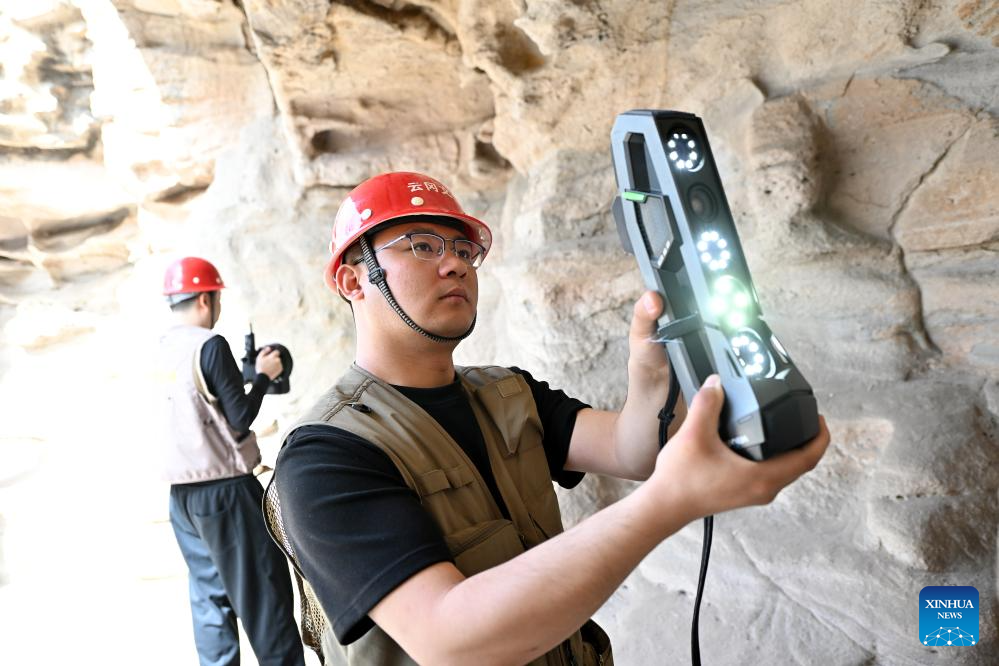
Pan Bo (R), a staff member of the research institute of the Yungang Grottoes, collects data at the grottoes in Datong, north China's Shanxi Province, April 16, 2025. Yungang Grottoes was built during the Northern Wei Dynasty (386-534). It is considered a pinnacle of Chinese Buddhist art and represents the highest level of sculptural artistry in the world during the 5th century.
In recent years, Shanxi has made great efforts to protect and study the grottoes. In 2021, the research institute of the Yungang Grottoes was established for the protection, research and management of the Yungang Grottoes.
Since 2003, the UNESCO World Heritage Site has started the digitization of its 45 major caves and more than 59,000 stone statues that are threatened by weathering. Cutting-edge technology has been used to record details of the Buddhist artworks, paving the way for their 3D digital reconstruction.
At present, the Yungang Grottoes scenic area has upgraded tourist facilities and offers various educational programs, receiving 4.44 million trips in 2024. (Xinhua/Zhan Yan)
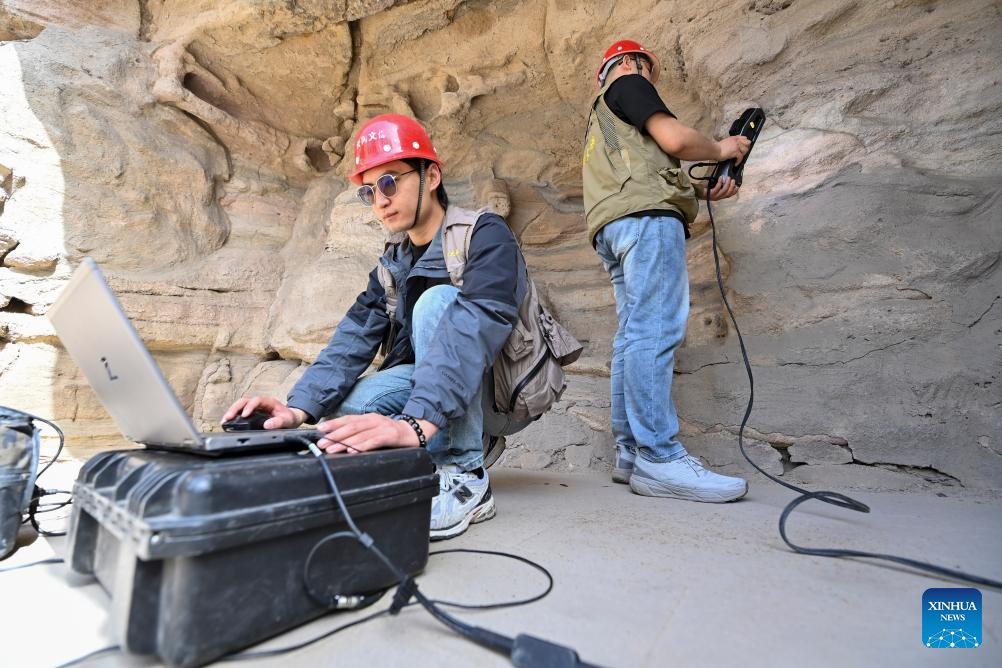
Huang Yifan (L), a staff member of the research institute of the Yungang Grottoes, collects data at the grottoes in Datong, north China's Shanxi Province, April 16, 2025. Yungang Grottoes was built during the Northern Wei Dynasty (386-534). It is considered a pinnacle of Chinese Buddhist art and represents the highest level of sculptural artistry in the world during the 5th century.
In recent years, Shanxi has made great efforts to protect and study the grottoes. In 2021, the research institute of the Yungang Grottoes was established for the protection, research and management of the Yungang Grottoes.
Since 2003, the UNESCO World Heritage Site has started the digitization of its 45 major caves and more than 59,000 stone statues that are threatened by weathering. Cutting-edge technology has been used to record details of the Buddhist artworks, paving the way for their 3D digital reconstruction.
At present, the Yungang Grottoes scenic area has upgraded tourist facilities and offers various educational programs, receiving 4.44 million trips in 2024. (Xinhua/Yang Chenguang)
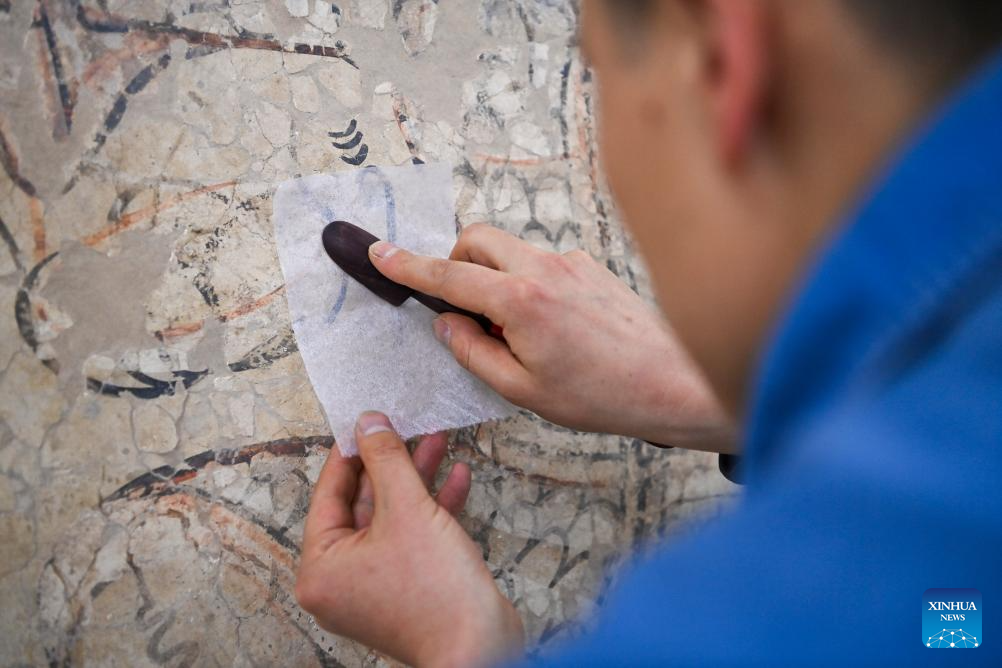
Dai Yuxiang, a staff member of the research institute of the Yungang Grottoes, restores a mural of the grottoes at the institute in Datong, north China's Shanxi Province, April 15, 2025. Yungang Grottoes was built during the Northern Wei Dynasty (386-534). It is considered a pinnacle of Chinese Buddhist art and represents the highest level of sculptural artistry in the world during the 5th century.
In recent years, Shanxi has made great efforts to protect and study the grottoes. In 2021, the research institute of the Yungang Grottoes was established for the protection, research and management of the Yungang Grottoes.
Since 2003, the UNESCO World Heritage Site has started the digitization of its 45 major caves and more than 59,000 stone statues that are threatened by weathering. Cutting-edge technology has been used to record details of the Buddhist artworks, paving the way for their 3D digital reconstruction.
At present, the Yungang Grottoes scenic area has upgraded tourist facilities and offers various educational programs, receiving 4.44 million trips in 2024. (Xinhua/Yang Chenguang)

Wang Na, a staff member of the research institute of the Yungang Grottoes, displays a 3D-printed Buddha statue at an exhibition hall of the institute in Datong, north China's Shanxi Province, April 16, 2025. Yungang Grottoes was built during the Northern Wei Dynasty (386-534). It is considered a pinnacle of Chinese Buddhist art and represents the highest level of sculptural artistry in the world during the 5th century.
In recent years, Shanxi has made great efforts to protect and study the grottoes. In 2021, the research institute of the Yungang Grottoes was established for the protection, research and management of the Yungang Grottoes.
Since 2003, the UNESCO World Heritage Site has started the digitization of its 45 major caves and more than 59,000 stone statues that are threatened by weathering. Cutting-edge technology has been used to record details of the Buddhist artworks, paving the way for their 3D digital reconstruction.
At present, the Yungang Grottoes scenic area has upgraded tourist facilities and offers various educational programs, receiving 4.44 million trips in 2024. (Xinhua/Yang Chenguang)
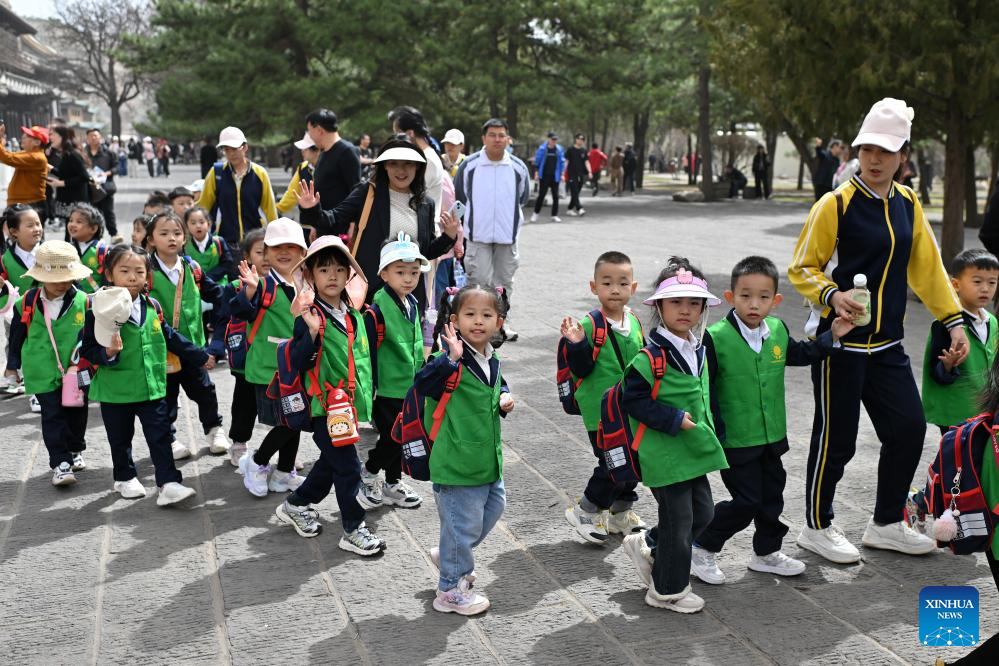
Children visit Yungang Grottoes under the guidance of their teachers in Datong, north China's Shanxi Province, April 16, 2025. Yungang Grottoes was built during the Northern Wei Dynasty (386-534). It is considered a pinnacle of Chinese Buddhist art and represents the highest level of sculptural artistry in the world during the 5th century.
In recent years, Shanxi has made great efforts to protect and study the grottoes. In 2021, the research institute of the Yungang Grottoes was established for the protection, research and management of the Yungang Grottoes.
Since 2003, the UNESCO World Heritage Site has started the digitization of its 45 major caves and more than 59,000 stone statues that are threatened by weathering. Cutting-edge technology has been used to record details of the Buddhist artworks, paving the way for their 3D digital reconstruction.
At present, the Yungang Grottoes scenic area has upgraded tourist facilities and offers various educational programs, receiving 4.44 million trips in 2024. (Xinhua/Zhan Yan)
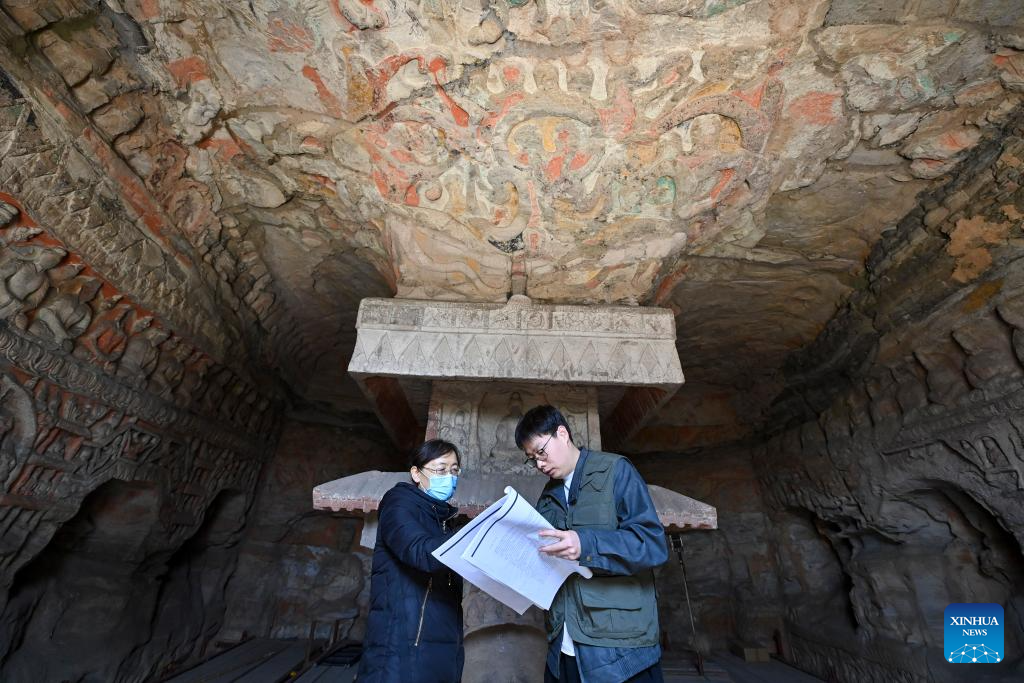
Wang Yanqing (L) and Ma Junyu, staff members of the research institute of the Yungang Grottoes, conduct an archaeological investigation at the grottoes in Datong, north China's Shanxi Province, April 15, 2025. Yungang Grottoes was built during the Northern Wei Dynasty (386-534). It is considered a pinnacle of Chinese Buddhist art and represents the highest level of sculptural artistry in the world during the 5th century.
In recent years, Shanxi has made great efforts to protect and study the grottoes. In 2021, the research institute of the Yungang Grottoes was established for the protection, research and management of the Yungang Grottoes.
Since 2003, the UNESCO World Heritage Site has started the digitization of its 45 major caves and more than 59,000 stone statues that are threatened by weathering. Cutting-edge technology has been used to record details of the Buddhist artworks, paving the way for their 3D digital reconstruction.
At present, the Yungang Grottoes scenic area has upgraded tourist facilities and offers various educational programs, receiving 4.44 million trips in 2024. (Xinhua/Yang Chenguang)

A staff member of the research institute of the Yungang Grottoes restores ironware of the grottoes at the institute in Datong, north China's Shanxi Province, April 15, 2025. Yungang Grottoes was built during the Northern Wei Dynasty (386-534). It is considered a pinnacle of Chinese Buddhist art and represents the highest level of sculptural artistry in the world during the 5th century.
In recent years, Shanxi has made great efforts to protect and study the grottoes. In 2021, the research institute of the Yungang Grottoes was established for the protection, research and management of the Yungang Grottoes.
Since 2003, the UNESCO World Heritage Site has started the digitization of its 45 major caves and more than 59,000 stone statues that are threatened by weathering. Cutting-edge technology has been used to record details of the Buddhist artworks, paving the way for their 3D digital reconstruction.
At present, the Yungang Grottoes scenic area has upgraded tourist facilities and offers various educational programs, receiving 4.44 million trips in 2024. (Xinhua/Zhan Yan)

Zhang Fan, a staff member of the research institute of the Yungang Grottoes, analyzes the sample of the grottoes wall at the institute in Datong, north China's Shanxi Province, April 16, 2025. Yungang Grottoes was built during the Northern Wei Dynasty (386-534). It is considered a pinnacle of Chinese Buddhist art and represents the highest level of sculptural artistry in the world during the 5th century.
In recent years, Shanxi has made great efforts to protect and study the grottoes. In 2021, the research institute of the Yungang Grottoes was established for the protection, research and management of the Yungang Grottoes.
Since 2003, the UNESCO World Heritage Site has started the digitization of its 45 major caves and more than 59,000 stone statues that are threatened by weathering. Cutting-edge technology has been used to record details of the Buddhist artworks, paving the way for their 3D digital reconstruction.
At present, the Yungang Grottoes scenic area has upgraded tourist facilities and offers various educational programs, receiving 4.44 million trips in 2024. (Xinhua/Yang Chenguang)

Zhang Fan, a staff member of the research institute of the Yungang Grottoes, weighs the sample of the grottoes wall at the institute in Datong, north China's Shanxi Province, April 16, 2025. Yungang Grottoes was built during the Northern Wei Dynasty (386-534). It is considered a pinnacle of Chinese Buddhist art and represents the highest level of sculptural artistry in the world during the 5th century.
In recent years, Shanxi has made great efforts to protect and study the grottoes. In 2021, the research institute of the Yungang Grottoes was established for the protection, research and management of the Yungang Grottoes.
Since 2003, the UNESCO World Heritage Site has started the digitization of its 45 major caves and more than 59,000 stone statues that are threatened by weathering. Cutting-edge technology has been used to record details of the Buddhist artworks, paving the way for their 3D digital reconstruction.
At present, the Yungang Grottoes scenic area has upgraded tourist facilities and offers various educational programs, receiving 4.44 million trips in 2024. (Xinhua/Yang Chenguang)
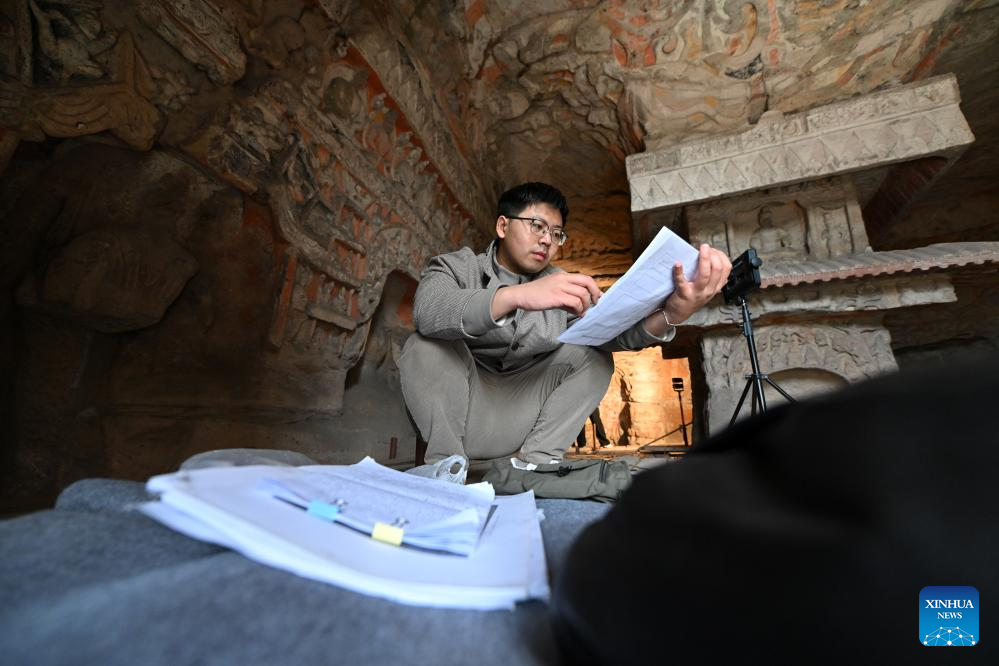
A staff member of the research institute of the Yungang Grottoes conducts an archaeological investigation at the grottoes in Datong, north China's Shanxi Province, April 16, 2025. Yungang Grottoes was built during the Northern Wei Dynasty (386-534). It is considered a pinnacle of Chinese Buddhist art and represents the highest level of sculptural artistry in the world during the 5th century.
In recent years, Shanxi has made great efforts to protect and study the grottoes. In 2021, the research institute of the Yungang Grottoes was established for the protection, research and management of the Yungang Grottoes.
Since 2003, the UNESCO World Heritage Site has started the digitization of its 45 major caves and more than 59,000 stone statues that are threatened by weathering. Cutting-edge technology has been used to record details of the Buddhist artworks, paving the way for their 3D digital reconstruction.
At present, the Yungang Grottoes scenic area has upgraded tourist facilities and offers various educational programs, receiving 4.44 million trips in 2024. (Xinhua/Zhan Yan)
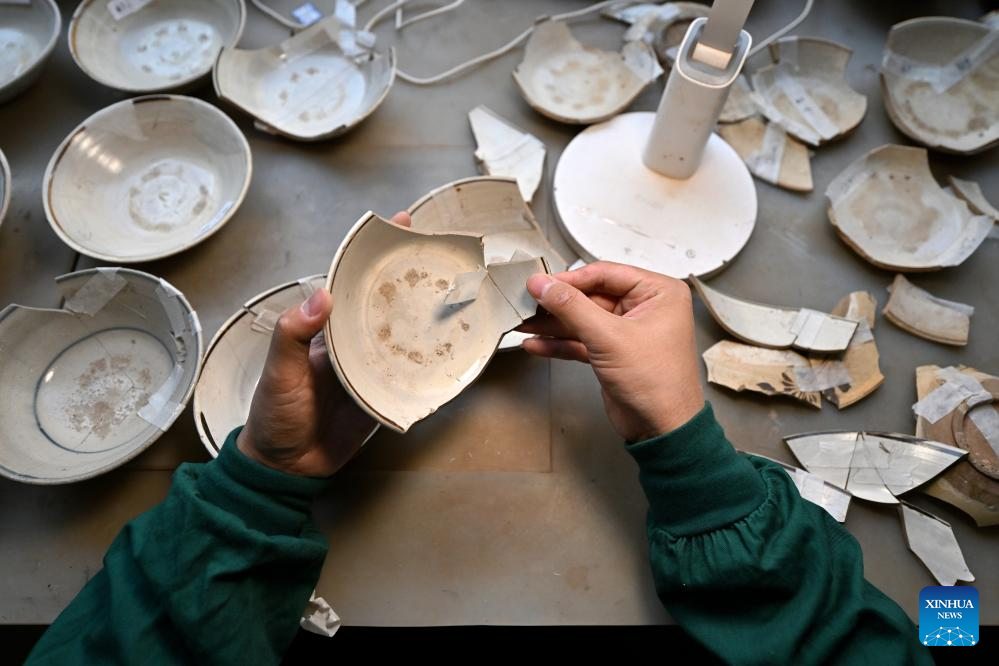
A staff member of the research institute of the Yungang Grottoes restores broken porcelain of the grottoes at the institute in Datong, north China's Shanxi Province, April 15, 2025. Yungang Grottoes was built during the Northern Wei Dynasty (386-534). It is considered a pinnacle of Chinese Buddhist art and represents the highest level of sculptural artistry in the world during the 5th century.
In recent years, Shanxi has made great efforts to protect and study the grottoes. In 2021, the research institute of the Yungang Grottoes was established for the protection, research and management of the Yungang Grottoes.
Since 2003, the UNESCO World Heritage Site has started the digitization of its 45 major caves and more than 59,000 stone statues that are threatened by weathering. Cutting-edge technology has been used to record details of the Buddhist artworks, paving the way for their 3D digital reconstruction.
At present, the Yungang Grottoes scenic area has upgraded tourist facilities and offers various educational programs, receiving 4.44 million trips in 2024. (Xinhua/Zhan Yan)

Dai Yuxiang, a staff member of the research institute of the Yungang Grottoes, chooses tools to restore a mural of the grottoes at the institute in Datong, north China's Shanxi Province, April 15, 2025. Yungang Grottoes was built during the Northern Wei Dynasty (386-534). It is considered a pinnacle of Chinese Buddhist art and represents the highest level of sculptural artistry in the world during the 5th century.
In recent years, Shanxi has made great efforts to protect and study the grottoes. In 2021, the research institute of the Yungang Grottoes was established for the protection, research and management of the Yungang Grottoes.
Since 2003, the UNESCO World Heritage Site has started the digitization of its 45 major caves and more than 59,000 stone statues that are threatened by weathering. Cutting-edge technology has been used to record details of the Buddhist artworks, paving the way for their 3D digital reconstruction.
At present, the Yungang Grottoes scenic area has upgraded tourist facilities and offers various educational programs, receiving 4.44 million trips in 2024. (Xinhua/Yang Chenguang)

Dai Yuxiang, a staff member of the research institute of the Yungang Grottoes, restores a mural of the grottoes at the institute in Datong, north China's Shanxi Province, April 15, 2025. Yungang Grottoes was built during the Northern Wei Dynasty (386-534). It is considered a pinnacle of Chinese Buddhist art and represents the highest level of sculptural artistry in the world during the 5th century.
In recent years, Shanxi has made great efforts to protect and study the grottoes. In 2021, the research institute of the Yungang Grottoes was established for the protection, research and management of the Yungang Grottoes.
Since 2003, the UNESCO World Heritage Site has started the digitization of its 45 major caves and more than 59,000 stone statues that are threatened by weathering. Cutting-edge technology has been used to record details of the Buddhist artworks, paving the way for their 3D digital reconstruction.
At present, the Yungang Grottoes scenic area has upgraded tourist facilities and offers various educational programs, receiving 4.44 million trips in 2024. (Xinhua/Yang Chenguang)
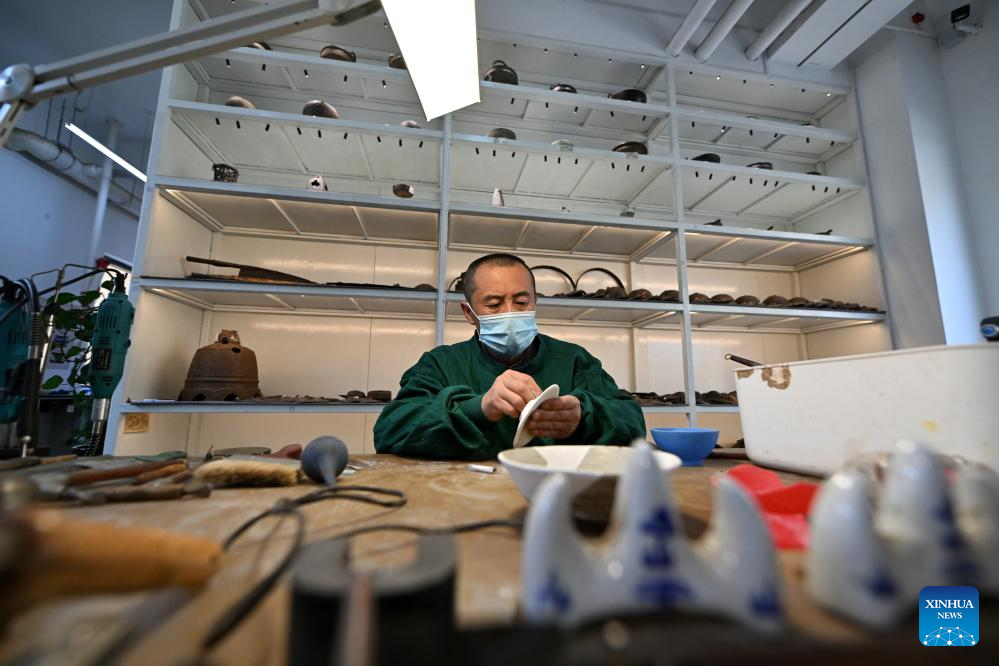
Liu Quanyi, a staff member of the research institute of the Yungang Grottoes, restores porcelain of the grottoes at the institute in Datong, north China's Shanxi Province, April 15, 2025. Yungang Grottoes was built during the Northern Wei Dynasty (386-534). It is considered a pinnacle of Chinese Buddhist art and represents the highest level of sculptural artistry in the world during the 5th century.
In recent years, Shanxi has made great efforts to protect and study the grottoes. In 2021, the research institute of the Yungang Grottoes was established for the protection, research and management of the Yungang Grottoes.
Since 2003, the UNESCO World Heritage Site has started the digitization of its 45 major caves and more than 59,000 stone statues that are threatened by weathering. Cutting-edge technology has been used to record details of the Buddhist artworks, paving the way for their 3D digital reconstruction.
At present, the Yungang Grottoes scenic area has upgraded tourist facilities and offers various educational programs, receiving 4.44 million trips in 2024. (Xinhua/Zhan Yan)
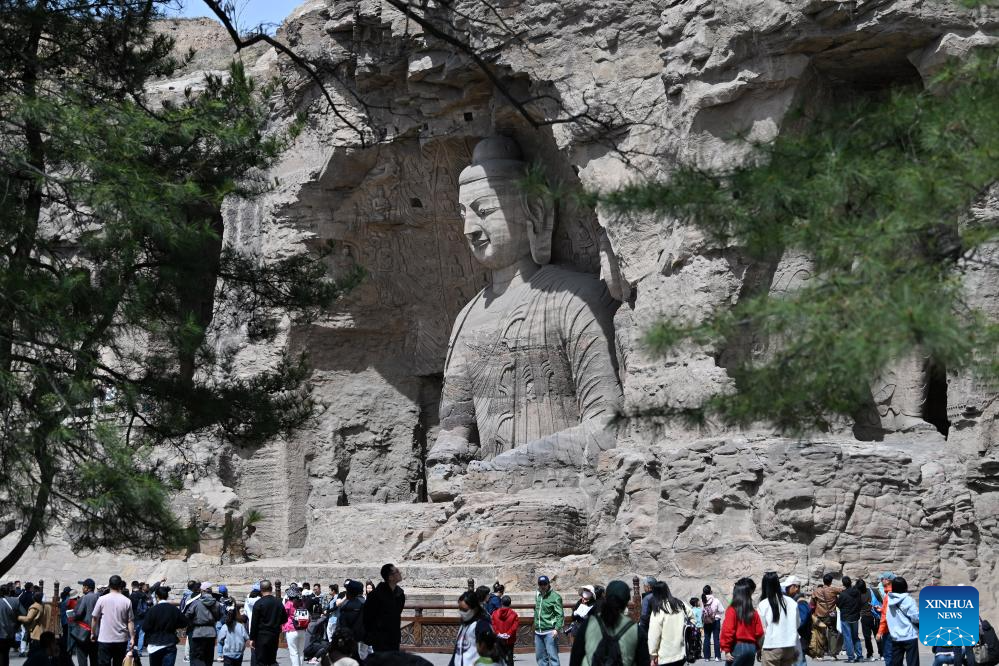
Tourists visit Yungang Grottoes in Datong, north China's Shanxi Province, April 16, 2025. Yungang Grottoes was built during the Northern Wei Dynasty (386-534). It is considered a pinnacle of Chinese Buddhist art and represents the highest level of sculptural artistry in the world during the 5th century.
In recent years, Shanxi has made great efforts to protect and study the grottoes. In 2021, the research institute of the Yungang Grottoes was established for the protection, research and management of the Yungang Grottoes.
Since 2003, the UNESCO World Heritage Site has started the digitization of its 45 major caves and more than 59,000 stone statues that are threatened by weathering. Cutting-edge technology has been used to record details of the Buddhist artworks, paving the way for their 3D digital reconstruction.
At present, the Yungang Grottoes scenic area has upgraded tourist facilities and offers various educational programs, receiving 4.44 million trips in 2024. (Xinhua/Zhan Yan)
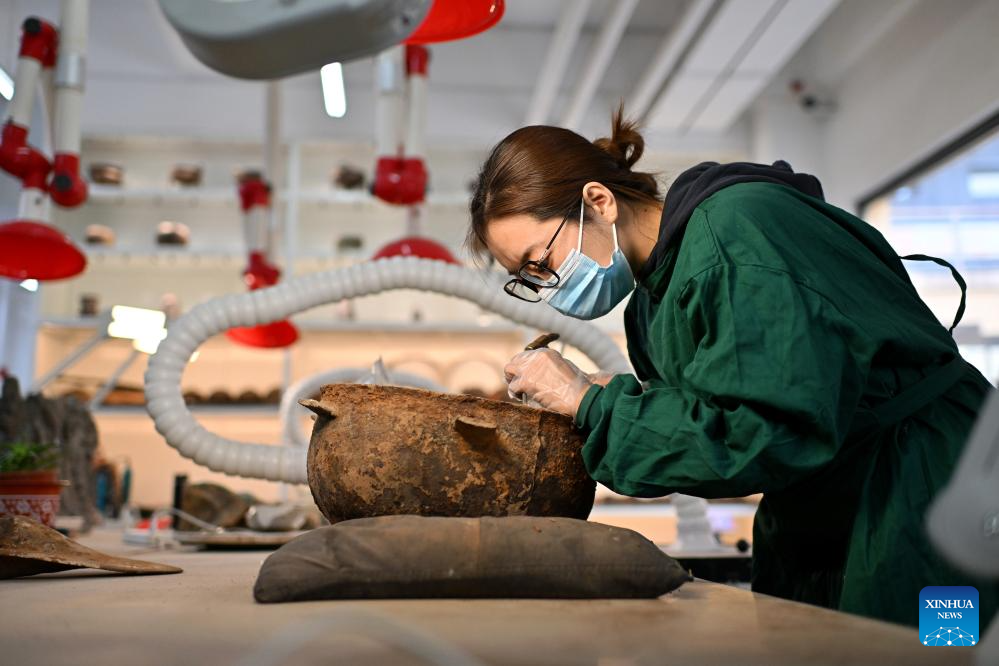
Sun Lina, a staff member of the research institute of the Yungang Grottoes, restores ironware of the grottoes at the institute in Datong, north China's Shanxi Province, April 15, 2025. Yungang Grottoes was built during the Northern Wei Dynasty (386-534). It is considered a pinnacle of Chinese Buddhist art and represents the highest level of sculptural artistry in the world during the 5th century.
In recent years, Shanxi has made great efforts to protect and study the grottoes. In 2021, the research institute of the Yungang Grottoes was established for the protection, research and management of the Yungang Grottoes.
Since 2003, the UNESCO World Heritage Site has started the digitization of its 45 major caves and more than 59,000 stone statues that are threatened by weathering. Cutting-edge technology has been used to record details of the Buddhist artworks, paving the way for their 3D digital reconstruction.
At present, the Yungang Grottoes scenic area has upgraded tourist facilities and offers various educational programs, receiving 4.44 million trips in 2024. (Xinhua/Zhan Yan)
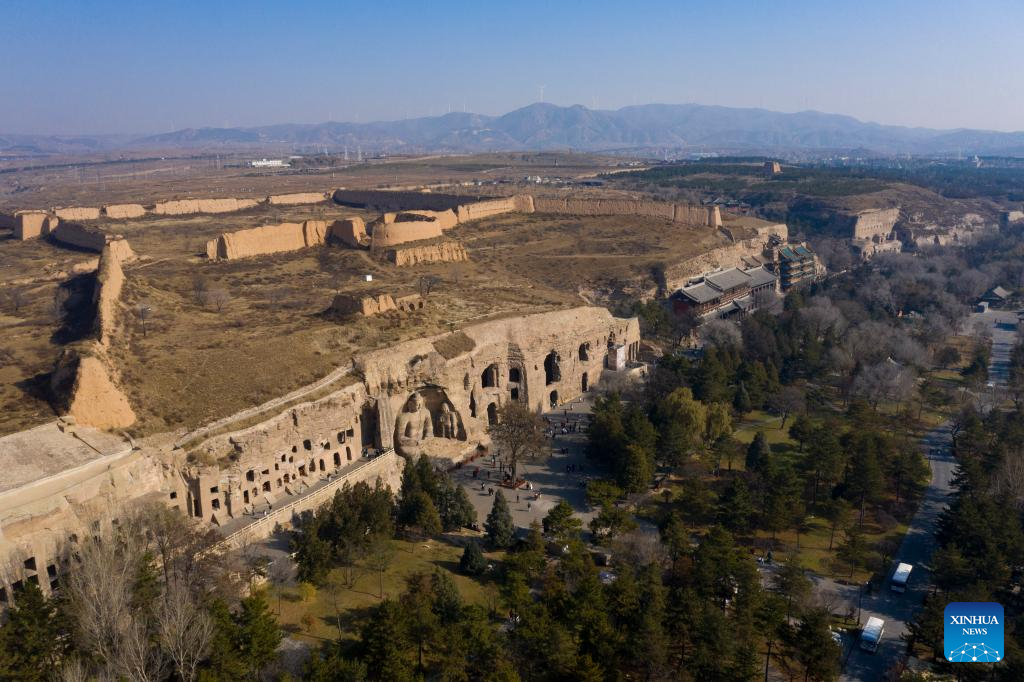
An aerial drone photo shows a panoramic view of Yungang Grottoes in Datong, north China's Shanxi Province, Nov. 7, 2024. Yungang Grottoes was built during the Northern Wei Dynasty (386-534). It is considered a pinnacle of Chinese Buddhist art and represents the highest level of sculptural artistry in the world during the 5th century.
In recent years, Shanxi has made great efforts to protect and study the grottoes. In 2021, the research institute of the Yungang Grottoes was established for the protection, research and management of the Yungang Grottoes.
Since 2003, the UNESCO World Heritage Site has started the digitization of its 45 major caves and more than 59,000 stone statues that are threatened by weathering. Cutting-edge technology has been used to record details of the Buddhist artworks, paving the way for their 3D digital reconstruction.
At present, the Yungang Grottoes scenic area has upgraded tourist facilities and offers various educational programs, receiving 4.44 million trips in 2024. (Xinhua/Yang Chenguang)
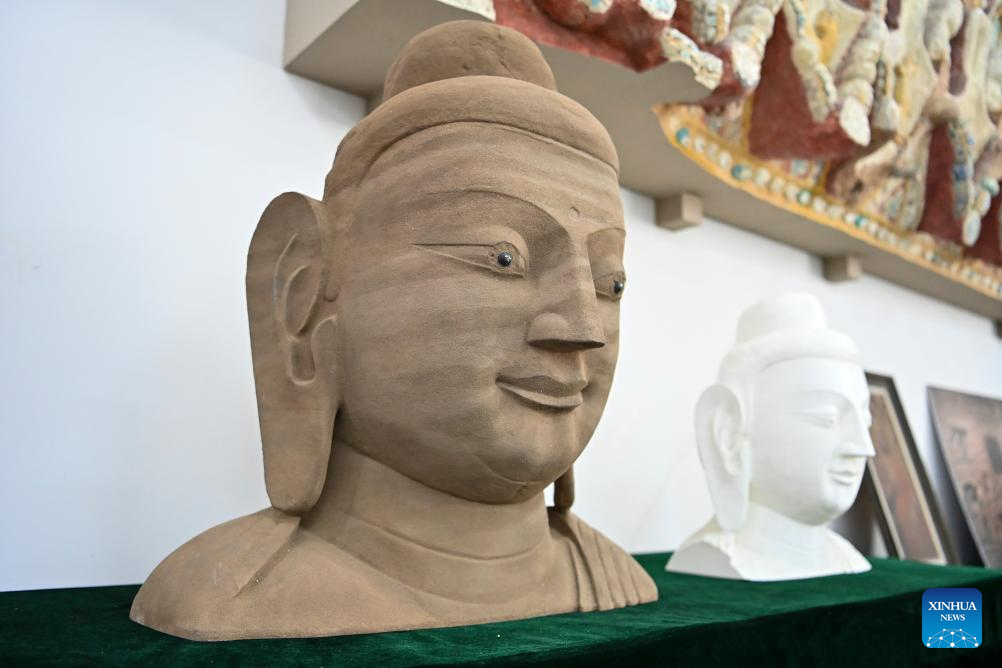
This photo shows 3D-printed Buddha statues at an exhibition hall of the research institute of the Yungang Grottoes in Datong, north China's Shanxi Province, April 16, 2025. Yungang Grottoes was built during the Northern Wei Dynasty (386-534). It is considered a pinnacle of Chinese Buddhist art and represents the highest level of sculptural artistry in the world during the 5th century.
In recent years, Shanxi has made great efforts to protect and study the grottoes. In 2021, the research institute of the Yungang Grottoes was established for the protection, research and management of the Yungang Grottoes.
Since 2003, the UNESCO World Heritage Site has started the digitization of its 45 major caves and more than 59,000 stone statues that are threatened by weathering. Cutting-edge technology has been used to record details of the Buddhist artworks, paving the way for their 3D digital reconstruction.
At present, the Yungang Grottoes scenic area has upgraded tourist facilities and offers various educational programs, receiving 4.44 million trips in 2024. (Xinhua/Yang Chenguang)

Wang Chao (L), a staff member of the research institute of the Yungang Grottoes, collects data at the grottoes in Datong, north China's Shanxi Province, April 16, 2025. Yungang Grottoes was built during the Northern Wei Dynasty (386-534). It is considered a pinnacle of Chinese Buddhist art and represents the highest level of sculptural artistry in the world during the 5th century.
In recent years, Shanxi has made great efforts to protect and study the grottoes. In 2021, the research institute of the Yungang Grottoes was established for the protection, research and management of the Yungang Grottoes.
Since 2003, the UNESCO World Heritage Site has started the digitization of its 45 major caves and more than 59,000 stone statues that are threatened by weathering. Cutting-edge technology has been used to record details of the Buddhist artworks, paving the way for their 3D digital reconstruction.
At present, the Yungang Grottoes scenic area has upgraded tourist facilities and offers various educational programs, receiving 4.44 million trips in 2024. (Xinhua/Yang Chenguang)
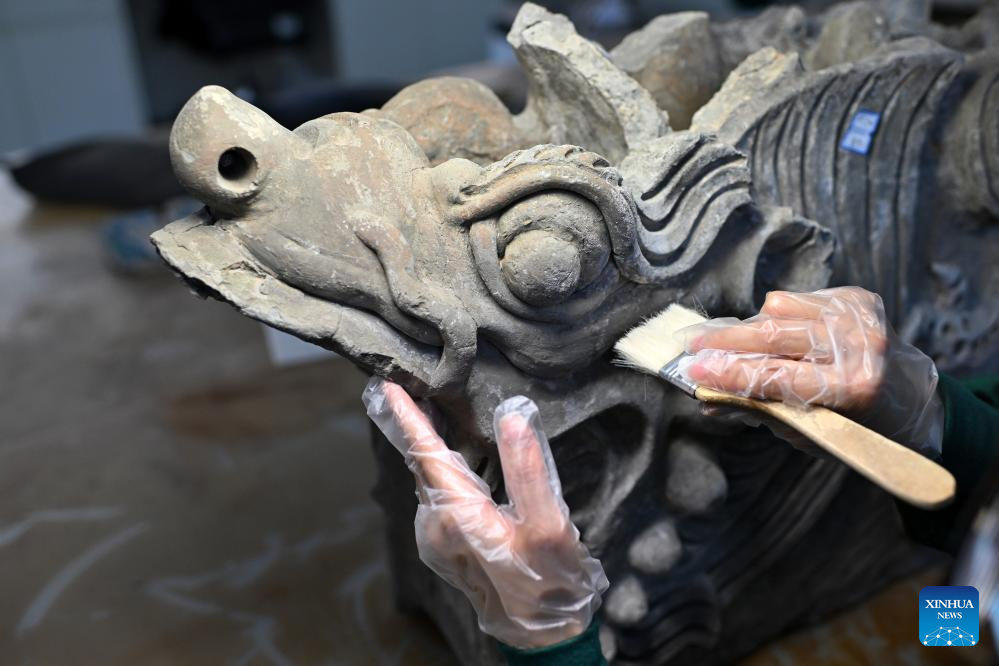
A staff member of the research institute of the Yungang Grottoes dusts a cultural relic of the grottoes at the institute in Datong, north China's Shanxi Province, April 15, 2025. Yungang Grottoes was built during the Northern Wei Dynasty (386-534). It is considered a pinnacle of Chinese Buddhist art and represents the highest level of sculptural artistry in the world during the 5th century.
In recent years, Shanxi has made great efforts to protect and study the grottoes. In 2021, the research institute of the Yungang Grottoes was established for the protection, research and management of the Yungang Grottoes.
Since 2003, the UNESCO World Heritage Site has started the digitization of its 45 major caves and more than 59,000 stone statues that are threatened by weathering. Cutting-edge technology has been used to record details of the Buddhist artworks, paving the way for their 3D digital reconstruction.
At present, the Yungang Grottoes scenic area has upgraded tourist facilities and offers various educational programs, receiving 4.44 million trips in 2024. (Xinhua/Zhan Yan)



